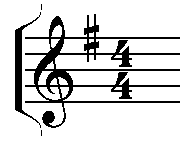Musical pieces are read much like you would read math symbols. The symbols represent some bit of information about the piece. Musical pieces are divided into sections called measures or bars. Each measure embodies an equal amount of time. Furthermore, each measure is divided into equal portions called beats. These are all mathematical divisions of time.
Fractions are used in music to indicate lengths of notes. In a musical piece, the time signature tells the musician information about the rhythm of the piece. A time signature is generally written as two integers, one above the other. The number on the bottom tells the musician which note in the piece gets a single beat (count). The top number tells the musician how many of this note is in each measure. Numbers can tell us a lot about musical pieces.
 Image reproduced with permission of Neil Hawes |
Each note has a different shape to indicate its beat length or time. Notes are classified in terms of numbers as well. There are whole notes (one note per measure), half notes (two notes per measure), quarter notes (four notes per measure), eighth notes (eight notes per measure), and sixteenth notes (sixteen notes per measure). These numbers signify how long the notes last. That is, a whole note would last through the entire measure whereas a quarter note would only last ¼ of the measure and thus there is enough time for four quarter notes in one measure. This can be expressed mathematically since 4 x 1/4 = 1. A note with a dot after it lengthens the note by half. For example, a quarter note with a dot after it would be held for 3/8
of a measure, since
![]()
Three eigths of a measure is midway between a quarter note and a half note. It is important for musicians to understand the relationships and values of fractions in order to correctly hold a note.
